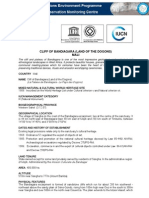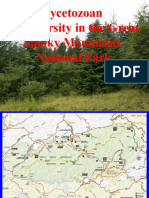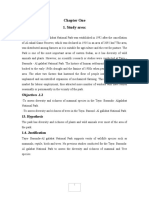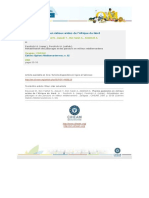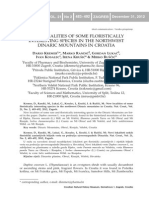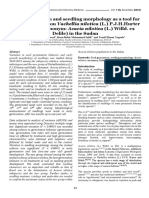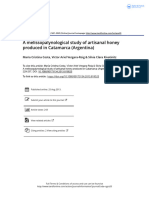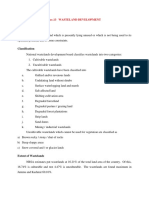Professional Documents
Culture Documents
Gs 7 Income Sandy Grassland
Uploaded by
Shelton TsangaCopyright
Share this document
Did you find this document useful?
Is this content inappropriate?
Report this DocumentGs 7 Income Sandy Grassland
Uploaded by
Shelton TsangaGs 7 Income Sandy Grassland
VT 66 Natal Sour Sandveld (68%) (Acocks 1953). LR 25 Natal Central Bushveld (85%) (Low & Rebelo 1996). BRG 14 Sour Sandveld (76%)
(Camp 1999c).
Distribution KwaZulu-Natal Province: In a large triangle between Newcastle, Vryheid and Dundee and larger
polygon in the Wasbank area in northern KwaZulu-Natal. Altitude 880–1 340 m (mainly 1 120–1 240 m).
Vegetation & Landscape Features Very flat extensive areas with generally shallow, poorly drained, sandy soils
supporting low, tussock-dominated sourveld forming a mosaic with wooded grasslands (with Acacia sieberiana
var. woodii) and on well-drained sites with the trees A. karroo, A. nilotica, A. caffra and Diospyros lycioides. On
disturbed sites A. sieberiana var. woodii can form sparse woodlands. Aristida congesta, Cynodon dactylon and
Microchloa caffra are common on shallow soils (Camp 1999c).
Geology & Soils Sandstones and shale of the Madzaringwe Formation (Ecca Group of Karoo Supergroup)
supporting poorly drained sandy soils, mostly of the Glenrosa form. Most important land types Ca, Bb and Fb.
Climate Region of summer rainfall, with most precipitation occurring between October and March (overall MAP
750 mm; range 650–800 mm), much of which falls as thundershowers often accompanied by hail. MAT is just
below 17°C, and mean annual evaporation 1 845 mm. Frost moderate (Camp 1999c). See also climate diagram
for Gs 7 Income Sandy Grassland (Figure 8.61).
Important Taxa Graminoids: Andropogon appendiculatus (d), Brachiaria serrata (d), Cynodon dactylon (d),
Digitaria monodactyla (d), D. tricholaenoides (d), Eragrostis curvula (d), E. gummiflua (d), E. plana (d), E.
racemosa (d), Heteropogon contortus (d), Hyparrhenia hirta (d), Loudetia simplex (d), Paspalum scrobiculatum
(d), Tristachya leucothrix (d), Alloteropsis semialata subsp. eckloniana, Andropogon eucomus, A. schirensis,
Aristida congesta, A. junciformis subsp. galpinii, Cymbopogon caesius, Diheteropogon amplectens, D. filifolius,
Elionurus muticus, Eragrostis capensis, E. chloromelas, E. planiculmis, E. sclerantha, Harpochloa falx, Melinis
repens subsp. repens, Microchloa caffra, Monocymbium ceresiiforme, Panicum natalense, Perotis patens,
Pogonarthria squarrosa, Setaria nigrirostris, Sporobolus africanus, Stiburus conrathii, Themeda triandra,
Trichoneura grandiglumis. Herbs: Helichrysum rugulosum (d), Berkheya onopordifolia var. glabra, B. setifera,
Chamaecrista mimosoides, Dicoma anomala, Euryops transvaalensis subsp. setilobus, Helichrysum caespititium,
H. cephaloideum, H. simillimum, Hermannia depressa, H. transvaalensis, Kohautia amatymbica, K. virgata,
Macledium zeyheri subsp. argyrophylum, Pentanisia prunelloides subsp. latifolia, Senecio coronatus, Zornia
capensis. Herbaceous Climber: Rhynchosia totta. Geophytic Herb: Hypoxis rigidula var. pilosissima. Low Shrubs:
Anthospermum rigidum subsp. pumilum, Stoebe plumosa.
Conservation Vulnerable. Target 23%. None conserved in statutory conservation areas. Some 27% has been
transformed for cultivation, plantations and by urban sprawl. Small portion of the area has been lost to the
building of dams (Klipfontein, Mvunyane). No serious invasions of aliens have been observed (probably due to
low nutrient status of soils). Erosion moderate (38%), high (30%) and low (15%).
Remarks The differences between this unit and the Gs 13 Mabela Sandy Grassland (in East Griqualand), lie
especially in some climatic and vegetation patterns. Cedarville (in Gs 13 Mabela Sandy Grassland) is much colder
(MAT 14°C), shows lower transpiration, has higher incidence of frost and hence lacks indigenous trees.
References Acocks (1953, 1988), Eckhardt et al. (1996a, b), Eckhardt (1998), Camp (1999c).
You might also like
- Rachel Joyce - A Snow Garden and Other Stories PDFDocument118 pagesRachel Joyce - A Snow Garden and Other Stories PDFИгорь ЯковлевNo ratings yet
- Underground Equipment SelectionDocument44 pagesUnderground Equipment SelectionCherotich Silas cheboseiNo ratings yet
- Cliffs of BandiagaraDocument5 pagesCliffs of BandiagaraHiramKB3No ratings yet
- Silviculture of Indian TreesDocument86 pagesSilviculture of Indian Treessneha0% (1)
- Brochure (Mountain Locks Park)Document2 pagesBrochure (Mountain Locks Park)MountainLocksPark100% (1)
- Landcover Mapping of Ayeyarwady Mangroves MYA93026Document42 pagesLandcover Mapping of Ayeyarwady Mangroves MYA93026Maung Maung ThanNo ratings yet
- Plants LCD HDocument5 pagesPlants LCD HToni NuariNo ratings yet
- Casuarina Equisetifolia: Casuarinaceae LDocument7 pagesCasuarina Equisetifolia: Casuarinaceae LsherenraditaNo ratings yet
- Mycetozoan Biodiversity in The Great Smoky Mountains National ParkDocument116 pagesMycetozoan Biodiversity in The Great Smoky Mountains National ParkjlandoltNo ratings yet
- PlantLife Volume 54.4, December 2022. Mafikeng Game ReserveDocument12 pagesPlantLife Volume 54.4, December 2022. Mafikeng Game ReserveJeff W MorrisNo ratings yet
- Chapter One 1. Study AreaDocument34 pagesChapter One 1. Study AreaAHMED AZHARINo ratings yet
- pswgtr188 001aDocument57 pagespswgtr188 001abtissam princesseNo ratings yet
- Bermuda Grass Cynodon Dactylon - WikipediaDocument19 pagesBermuda Grass Cynodon Dactylon - WikipediaRavindra Kumar VermaNo ratings yet
- History of Native Trees in ConnecticutDocument19 pagesHistory of Native Trees in ConnecticutElaine M. GeorgeNo ratings yet
- Strategies For Conservation of Germplasm in Endemic Redwoods in The Face of Climate Change: A ReviewDocument12 pagesStrategies For Conservation of Germplasm in Endemic Redwoods in The Face of Climate Change: A ReviewLeon MunteanNo ratings yet
- Los Bosques de Manglar en La Isla de San Andrés: April 1998Document11 pagesLos Bosques de Manglar en La Isla de San Andrés: April 1998danielaNo ratings yet
- Indigenous Plants of Latrobe CityDocument24 pagesIndigenous Plants of Latrobe CitylauraNo ratings yet
- Dragonflies and Damselflies Research Abstract - AJCB-Vol9-No2-Ramos Et AlDocument10 pagesDragonflies and Damselflies Research Abstract - AJCB-Vol9-No2-Ramos Et AlNorberto R. BautistaNo ratings yet
- 14 Lec 14 Wastelend DevelopmentDocument13 pages14 Lec 14 Wastelend DevelopmentKavieswarNo ratings yet
- Arundinaria Gigantea - WikipediaDocument3 pagesArundinaria Gigantea - WikipediaMohsin KhanNo ratings yet
- Biodiversity of The National Zoo (Sri Lanka)Document9 pagesBiodiversity of The National Zoo (Sri Lanka)D.M.S. Suranjan KarunarathnaNo ratings yet
- Plantes Pastorales en Milieux Arides de L'afrique Du NordDocument6 pagesPlantes Pastorales en Milieux Arides de L'afrique Du NordKenza RhimiNo ratings yet
- Landscaping and Gardening Around Walnuts and OtherDocument3 pagesLandscaping and Gardening Around Walnuts and OtherTrium ViratNo ratings yet
- Kremer Natcroat 2012 2Document10 pagesKremer Natcroat 2012 2Ir MaNo ratings yet
- Manda ZooDocument10 pagesManda ZooJsmBhanotNo ratings yet
- Western Native Plants ReferenceDocument2 pagesWestern Native Plants ReferenceSeanNo ratings yet
- Faidherbia Albida Prosopis AfricanaDocument18 pagesFaidherbia Albida Prosopis AfricanaMd Ashikur RahmanNo ratings yet
- Desert EcosystemDocument28 pagesDesert EcosystemSaim KhanNo ratings yet
- Oak Mortality Disease ControlDocument3 pagesOak Mortality Disease ControlC MNo ratings yet
- Forestry-Scientific-Name 1Document28 pagesForestry-Scientific-Name 1lovryantadenaamilingacadsNo ratings yet
- Journal Sample PDFDocument14 pagesJournal Sample PDFvickNo ratings yet
- Bamboo Resources Conservation and Utilization in MalaysiaDocument18 pagesBamboo Resources Conservation and Utilization in Malaysiauzaimy100% (1)
- 8123Document6 pages8123bharatNo ratings yet
- Tree Factsheet: Tectona Grandis LDocument4 pagesTree Factsheet: Tectona Grandis LChinnmayNo ratings yet
- Dragonfly MonitoringDocument80 pagesDragonfly MonitoringGareth BlakesleyNo ratings yet
- Kaziranga National ParkDocument13 pagesKaziranga National ParkRadhika AgarwalNo ratings yet
- Costa, M.C - A-melissopalynological-study-of-artisanal-honey-produced-in-Catamarca-Argentina - 2013Document10 pagesCosta, M.C - A-melissopalynological-study-of-artisanal-honey-produced-in-Catamarca-Argentina - 2013Silvia KivatinitzNo ratings yet
- TM 10-420 Emergency Food Plants & Poisonous Plants of The Pacific 1943Document164 pagesTM 10-420 Emergency Food Plants & Poisonous Plants of The Pacific 1943RonLayton100% (4)
- Mascarene Islands: Hotspot in The Indian Ocean IslandsDocument31 pagesMascarene Islands: Hotspot in The Indian Ocean IslandsKALYANI TRIBHUVANNo ratings yet
- A Stand Growth Model For Yield Regulation in North Queensland RainforestsDocument9 pagesA Stand Growth Model For Yield Regulation in North Queensland RainforestsDoris Crispin de la CruzNo ratings yet
- Dracaena RUSCACEAE: C. C. WalkerDocument8 pagesDracaena RUSCACEAE: C. C. WalkerGuillermo BenitezNo ratings yet
- Studies On The Traditional Uses of Plants of Malam Jabba Valley, District Swat, PakistanDocument48 pagesStudies On The Traditional Uses of Plants of Malam Jabba Valley, District Swat, PakistanAhmad RazaNo ratings yet
- Wildlife and Forest Management by Ameer AkramDocument6 pagesWildlife and Forest Management by Ameer AkrambinodvickyNo ratings yet
- Sandstone FloraDocument10 pagesSandstone FloraAnon BoletusNo ratings yet
- ClistwebDocument93 pagesClistwebMuhammad RusdiNo ratings yet
- Basic Characteristic of Selected Tree Species (Gliricidia Sepium)Document14 pagesBasic Characteristic of Selected Tree Species (Gliricidia Sepium)Juniar PrayogiNo ratings yet
- Ground CoversDocument80 pagesGround CoversMathew YoyakkyNo ratings yet
- Wasteland DevelopmentDocument10 pagesWasteland DevelopmentRatul SinhaNo ratings yet
- Jacaratia Mexicana Edible and Medicinal Plant Uses of Tropical Deciduous Forest Species Yucatecan Maya 1991Document13 pagesJacaratia Mexicana Edible and Medicinal Plant Uses of Tropical Deciduous Forest Species Yucatecan Maya 1991María José TorallaNo ratings yet
- Sampson98 Tortoise Remains LSADocument16 pagesSampson98 Tortoise Remains LSARomina MercadanteNo ratings yet
- Eucalyptus Robusta - MyrtaceaeDocument17 pagesEucalyptus Robusta - MyrtaceaeBernadin JioNo ratings yet
- Plantes Pastorales en Milieux Arides de L'afrique Du NordDocument6 pagesPlantes Pastorales en Milieux Arides de L'afrique Du NordKenza RhimiNo ratings yet
- Acacia DealbataDocument3 pagesAcacia DealbataSandra Giles RosasNo ratings yet
- Species Diversity of Odonata in Mimbilisan Protected Landscape, Misamis Oriental, PhilippinesDocument10 pagesSpecies Diversity of Odonata in Mimbilisan Protected Landscape, Misamis Oriental, PhilippinesKristal Cay AragonNo ratings yet
- Deserts: Antarctic and Arctic Are Deserts That Are Always Cold and Are The World's Largest. TheDocument4 pagesDeserts: Antarctic and Arctic Are Deserts That Are Always Cold and Are The World's Largest. TheZielleJe DestinyNo ratings yet
- A Taxonomic Listing, Including New Distribution Records, For Benthic, Seaweeds From Mecufi, Northern MozambiqueDocument5 pagesA Taxonomic Listing, Including New Distribution Records, For Benthic, Seaweeds From Mecufi, Northern MozambiqueDenigencia armandoNo ratings yet
- Biodiversity of Bellanwila-Attidiya Sanctuary (Sri Lanka)Document18 pagesBiodiversity of Bellanwila-Attidiya Sanctuary (Sri Lanka)D.M.S. Suranjan Karunarathna100% (1)
- Dalbergia MelanoxylonDocument5 pagesDalbergia MelanoxylonNeemahNo ratings yet
- Effects of Changes in Elephant Densities On The Environment and Other Species-How Much Do We Know?Document21 pagesEffects of Changes in Elephant Densities On The Environment and Other Species-How Much Do We Know?MadushanNo ratings yet
- 2014 Langham List (150219)Document1 page2014 Langham List (150219)api-241556394No ratings yet
- Pitot/Static Systems: Flight InstrumentsDocument11 pagesPitot/Static Systems: Flight InstrumentsRoel MendozaNo ratings yet
- Surface Finish Measurement NotesDocument32 pagesSurface Finish Measurement NotesAneez ShresthaNo ratings yet
- CS402 Mcqs MidTerm by Vu Topper RMDocument50 pagesCS402 Mcqs MidTerm by Vu Topper RMM. KhizarNo ratings yet
- Keyword 4: Keyword: Strength of The Mixture of AsphaltDocument2 pagesKeyword 4: Keyword: Strength of The Mixture of AsphaltJohn Michael GeneralNo ratings yet
- EXCEL For Pump DesignDocument2 pagesEXCEL For Pump Designkad-7No ratings yet
- Harmonic Analysis of Separately Excited DC Motor Drives Fed by Single Phase Controlled Rectifier and PWM RectifierDocument112 pagesHarmonic Analysis of Separately Excited DC Motor Drives Fed by Single Phase Controlled Rectifier and PWM RectifierGautam Umapathy0% (1)
- GSD Puppy Training Essentials PDFDocument2 pagesGSD Puppy Training Essentials PDFseja saulNo ratings yet
- Assessment of Diabetic FootDocument7 pagesAssessment of Diabetic FootChathiya Banu KrishenanNo ratings yet
- Crma Unit 1 Crma RolesDocument34 pagesCrma Unit 1 Crma Rolesumop3plsdn0% (1)
- Hevi-Bar II and Safe-Lec 2Document68 pagesHevi-Bar II and Safe-Lec 2elkabongscribdNo ratings yet
- Phrasal Verbs Related To HealthDocument2 pagesPhrasal Verbs Related To HealthKnuckles El Naco Narco LechugueroNo ratings yet
- Bardonna MenuDocument16 pagesBardonna MenuFarley ElliottNo ratings yet
- Wildlife Emergency and Critical CareDocument14 pagesWildlife Emergency and Critical CareRayssa PereiraNo ratings yet
- Sap Ewm OverviewDocument11 pagesSap Ewm OverviewsachinNo ratings yet
- Frye LGD As A Function of The Default Rate 091013 PDFDocument13 pagesFrye LGD As A Function of The Default Rate 091013 PDFSushant SinghNo ratings yet
- Maritime Management SystemsDocument105 pagesMaritime Management SystemsAndika AntakaNo ratings yet
- IBM BladeCenter S RedBookDocument36 pagesIBM BladeCenter S RedBookGuillermo García GándaraNo ratings yet
- Esterification Oil of WintergreenDocument8 pagesEsterification Oil of WintergreenMaria MahusayNo ratings yet
- Ujian 1 THN 4Document13 pagesUjian 1 THN 4Che Shuk ShukaNo ratings yet
- CulvertsDocument18 pagesCulvertsAmmar A. Ali100% (1)
- 2nd APJ Abdul Kalam Essay Writing CompetitionDocument2 pages2nd APJ Abdul Kalam Essay Writing CompetitionANURAG SINGHNo ratings yet
- Skincare Routine Order Cheat SheetDocument10 pagesSkincare Routine Order Cheat SheetYel Salenga100% (3)
- Cold Regions Science and TechnologyDocument8 pagesCold Regions Science and TechnologyAbraham SilesNo ratings yet
- Airport Security Post 9-11Document7 pagesAirport Security Post 9-11lewisNo ratings yet
- Rectifier 5G High Density Embedded Power (3U Power Rack, Three Phase Four Wire) E...Document4 pagesRectifier 5G High Density Embedded Power (3U Power Rack, Three Phase Four Wire) E...Lintas LtiNo ratings yet
- Technical Data Sheet: LPI HVSC PlusDocument2 pagesTechnical Data Sheet: LPI HVSC PlusNguyễn TấnNo ratings yet
- Anderson, Poul - Flandry 02 - A Circus of HellsDocument110 pagesAnderson, Poul - Flandry 02 - A Circus of Hellsgosai83No ratings yet
- Carrefour-SA Shopping Center TurkeyDocument2 pagesCarrefour-SA Shopping Center TurkeyVineet JogalekarNo ratings yet



